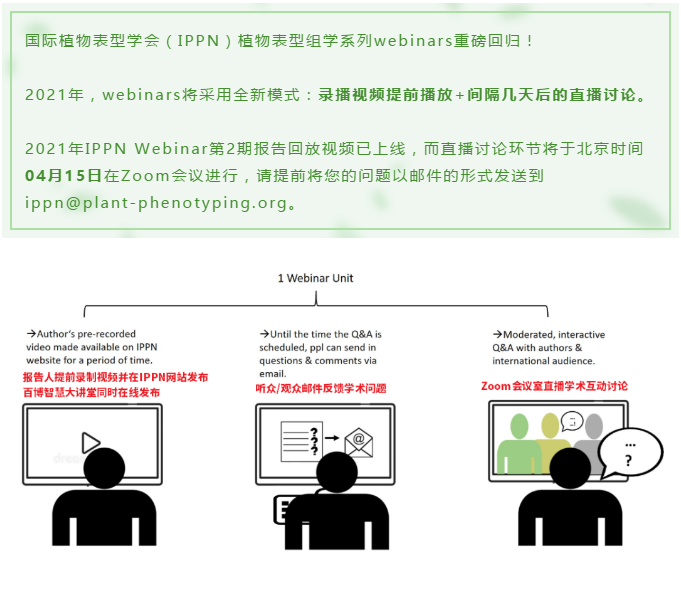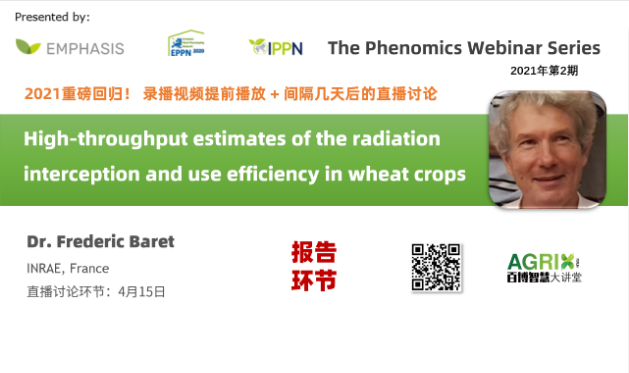学术中心
2021年IPPN Webinar第2期
发布时间:
2021-03-30
来源:
本站
作者:
慧诺瑞德

本期报告介绍:
题目:High-throughput estimates of the radiation interception and use efficiency in wheat crops
报告人:Fred Baret教授
线上报告:已在百博智慧大讲堂发布
线上讨论时间:04月15日(周四)

学术问题,邮件反馈给ippn@plant-phenotyping.org
04月15日,直播学术讨论环节
报告人介绍:
Frederic Baret received a PhD in the use of remote sensing for crop monitoring in 1986. He is currently research Director at INRAE, and invited professor at Nanjing Agricultural University. He coordinated several National and European projects. He is involved in the development of radiative transfer models at several scales (soil, leaf, canopy) and their use for the retrieval of vegetation biophysical variables. He developed retrieval algorithms (CYCLOPES, GEOV1, GEOV2, GEOV3, Sentinel-2) satellite and airborne sensors as well as close range remote sensing. He is deeply involved in the validation of remote sensing products and chaired the CEOS/LPV working group. He recently expanded his activity on high throughput phenotyping with the development of measurement systems as well as interpretation methods. He is in charge of the development of phenotyping methods in field conditions within the French Plant Phenotyping Network (PHENOME www.phenome-emphasis.fr) project. This includes the application of IoTs (sensors on fixed positions), phenomobiles (fully automatic robot rover) as well as the development of drone observations. He authored more than 255 research papers (h=61 WoK).
直播内容:
Biomass results the accumulation of the assimilates produced by the photosynthesis. The efficiency with which the incoming radiation is transformed into biomass depends on two terms: the radiation interception efficiency (RIE) and the Radiation use efficiency (RUE). The first term, RIE, quantifies the fraction of photosynthetically active radiation intercepted by the canopy. It can be accurately estimated in the field high-throughput measurements of the green fraction (GF) at 0° and 45° inclined directions. GF can be estimated several systems including high-resolution RGB cameras, LiDAR or multispectral cameras. The second term, RUE, quantifies the efficiency with which the intercepted radiation is transformed into biomass. Its computation requires measurements or estimates of the total biomass, which currently is difficult to get accurately high-throughput observations. This presentation draws the main advantages and limits of these techniques.
Coming up
"Phenotyping, ecophysiology and molecular physiology to characterize plant root system architecture and plant-plant and plant-microorganisms interactions"
Prof. Christophe Salon
INRAe, France
Pre-recorded talk will be available 15 April-6 May
Live Q&A with speaker: 6 May, 9:00 CET
"Digital phenotyping of individual plants and plant communities in the field"
Prof. Robert R. Junker
University of Marburg, Germany
Pre-recorded talk will be available 10 May-27 May
Live Q&A with speaker: 27 May, 14:00 CET
推荐新闻
视频展示
